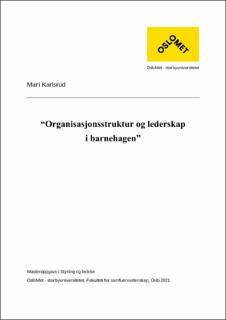| dc.description.abstract | The kindergarten sector has undergone major changes in recent decades, which has created a need for more kindergartens in Norway. In 2009 the right to a place for your child in a kindergarten was introduced, and more and larger kindergartens have been built. Both municipal and private actors have contributed towards to achieving full kindergarten coverage. The kindergarten's organisation is changing due to general societal development, changes in organisational form and new legal requirements. With close ties to the sector over many years, I have seen the importance of organizational structure in relation to leadership in kindergartens. With this survey, I therefore wish to shed light on changes in the kindergarten's organizational structure and leadership following the introduction of the new staff norm and the stricter pedagogical norm implemented in the autumn 2018.
The survey is based on previous research on kindergarten as an organization, leadership in kindergartens and various theoretical frameworks and perspectives. For the survey, I have chosen a qualitative method with individual interviews. The informants are the general manager and pedagogical leader in four selected kindergartens, a total of eight informants. All the informants have more than five years of experience as leaders in kindergartens.
Findings from the survey show that regardless of how the kindergarten was organised before the new norm was implemented in the autumn of 2018, changes in the organisational structure of kindergartens occurred as a result of the implementation. The informants describe changes in the structure that have only become apparent after implementation. This change in the structure of kindergartens, is because of several more kindergarten teachers in the organization than before.
Findings show that the new norms creates both challenges and opportunities for the kindergartens as an organization that there are more kindergarten teachers than before. It is positive for the kindergarten to have many kindergarten teachers, because it contributes to increased academic competence. But it is also challenging, because all kindergarten teachers have unbound working hours, which in short means planning time and time away from the ward or base. And also because it is hard to hire qualified staff in positions that require kindergarten teacher education. To some extent, the new norm has influenced the CEO's way of exercising leadership, as informants describe a greater shift towards governance than management due to more administrative work now than before. Pedagogical leaders report that the new norms does not influence their way of exercising leadership. They describe that their leadership focus more on leadership than governance. | en_US |
